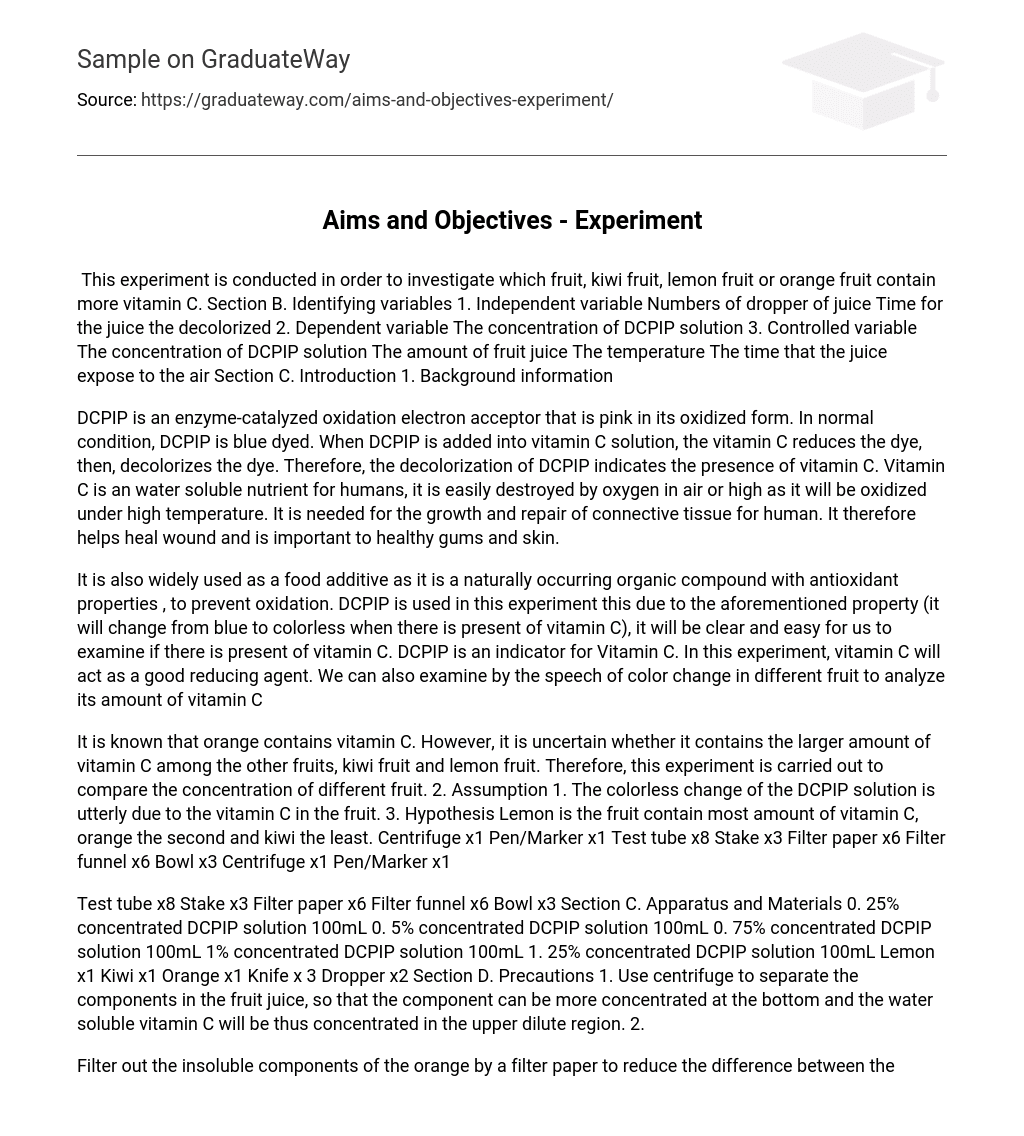This experiment is conducted in order to investigate which fruit, kiwi fruit, lemon fruit or orange fruit contain more vitamin C. Section B. Identifying variables 1. Independent variable Numbers of dropper of juice Time for the juice the decolorized 2. Dependent variable The concentration of DCPIP solution 3. Controlled variable The concentration of DCPIP solution The amount of fruit juice The temperature The time that the juice expose to the air Section C. Introduction 1. Background information
DCPIP is an enzyme-catalyzed oxidation electron acceptor that is pink in its oxidized form. In normal condition, DCPIP is blue dyed. When DCPIP is added into vitamin C solution, the vitamin C reduces the dye, then, decolorizes the dye. Therefore, the decolorization of DCPIP indicates the presence of vitamin C. Vitamin C is an water soluble nutrient for humans, it is easily destroyed by oxygen in air or high as it will be oxidized under high temperature. It is needed for the growth and repair of connective tissue for human. It therefore helps heal wound and is important to healthy gums and skin.
It is also widely used as a food additive as it is a naturally occurring organic compound with antioxidant properties , to prevent oxidation. DCPIP is used in this experiment this due to the aforementioned property (it will change from blue to colorless when there is present of vitamin C), it will be clear and easy for us to examine if there is present of vitamin C. DCPIP is an indicator for Vitamin C. In this experiment, vitamin C will act as a good reducing agent. We can also examine by the speech of color change in different fruit to analyze its amount of vitamin C
It is known that orange contains vitamin C. However, it is uncertain whether it contains the larger amount of vitamin C among the other fruits, kiwi fruit and lemon fruit. Therefore, this experiment is carried out to compare the concentration of different fruit. 2. Assumption 1. The colorless change of the DCPIP solution is utterly due to the vitamin C in the fruit. 3. Hypothesis Lemon is the fruit contain most amount of vitamin C, orange the second and kiwi the least. Centrifuge x1 Pen/Marker x1 Test tube x8 Stake x3 Filter paper x6 Filter funnel x6 Bowl x3 Centrifuge x1 Pen/Marker x1
Test tube x8 Stake x3 Filter paper x6 Filter funnel x6 Bowl x3 Section C. Apparatus and Materials 0. 25% concentrated DCPIP solution 100mL 0. 5% concentrated DCPIP solution 100mL 0. 75% concentrated DCPIP solution 100mL 1% concentrated DCPIP solution 100mL 1. 25% concentrated DCPIP solution 100mL Lemon x1 Kiwi x1 Orange x1 Knife x 3 Dropper x2 Section D. Precautions 1. Use centrifuge to separate the components in the fruit juice, so that the component can be more concentrated at the bottom and the water soluble vitamin C will be thus concentrated in the upper dilute region. 2.
Filter out the insoluble components of the orange by a filter paper to reduce the difference between the surface tension and water molecules, so to ensure that no suspended solid is tested and every drop of juice is the same using pipetter. 3. Extract both the soluble component and insoluble component in the centrifuged juice, so to ensure the accuracy of the amount of vitamin C in the juice are took into account. 4. Heat the juice which added DCPIP to destroy the reducing property of vitamin C and so there should be no color change in the solution. Upon heating, and in the presence of oxygen, it can be ensured that all vitamin C is reacted.
Section E. Procedures 1. The orange is placed on the table and cut into half with a knife. 2. The kiwi is placed on the table and cut into half with a knife.. 3. The lemon is placed on the table and cut into half with a knife. 4. The three different fruit are staked in separately in different bowl until there is enough juice for experiment. 5. The 3 filter funnels are placed on 3 individual test tubes, then 3 filter papers are placed in the 3 filter funnels. 6. The orange, kiwi and lemon juice are poured into the 3 individual test tubes separately and stirred carefully. . The 3 test tubes are then placed into the centrifuge. 8. Then, soluble component is extracted from the upper region of each centrifuged juice with a dropper. 9. The 0. 25,0. 5,0. 75, 1 and 1. 25 concentrated DCPIP solution is added into the 3 extracted vitamin C solution test tube drop by drop until. Stop when the DCPIP solution become colorless. ( The original color of the juice should be presented in the solution) 10. Test tubes are shaked gently after adding each drop of DCPIP solution. 11. Boil the test tube of vitamin C solution in a water bath for 5 minutes.
Allow the test tube cool. Repeat step 8-10 with the boiled vitamin C solution. 12. The time consumption for the each solution turn from blue to colorless is recorded and potted into a graph(against graph) 13. Refer to the against graph to find the graph with direct ratioin which x varies directly to y 14. Repeat step8 but extract the insoluble component form the lower region of each solution. 15. Repeat step9-12 16. Calculate the amount of vitamin C in the standard solution in mg cm–3. Calculate how much vitamin C there is in each of the fruit juices in mg cm–3.





